Europe in disarray over migrants
- Published
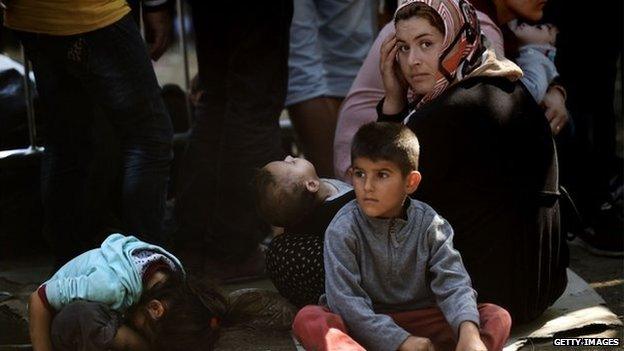
Many Syrian refugees are desperate to escape the fighting at home
For much of the past five years, Europe has been on edge; the crisis in the eurozone was seen as threatening the entire European project.
Leaders lined up to warn that: "If the euro fails, then Europe fails."
Now, in a brief passage of time, everything has changed.
German Chancellor Angela Merkel says the migrant crisis "will challenge us far more than Greece and the stability of the euro, external".
In Europe, the largest numbers of refugees is on the move since the aftermath of World War Two. An estimated 3,000 people a day are trying to make their future in Europe.
The crisis has overwhelmed Europe's leaders. There is no plan.
Existing rules for processing people where they arrive have been discarded.
Temporary border controls have re-emerged on what are supposed to be passport-free borders. Fences are being strengthened.
There is tension and finger-pointing. One prime minister accused other leaders of "not telling the truth", external about the migrants.
There will be an emergency meeting of interior ministers on 14 September.
It may well be followed by a summit of Europe's leaders.
Tough decisions ahead
What is clear is that the heads of government will face some hugely sensitive decisions that will determine whether an open Europe can survive.
This is a crisis that has been building for many years.
Europe has been torn between upholding its values of protecting the vulnerable from war and persecution and wanting to limit the numbers at a time when 18 million people in the eurozone are without work., external Youth unemployment is still at 21.9%.
For a long period, migration has been dealt with by deception and a political sleight of hand.
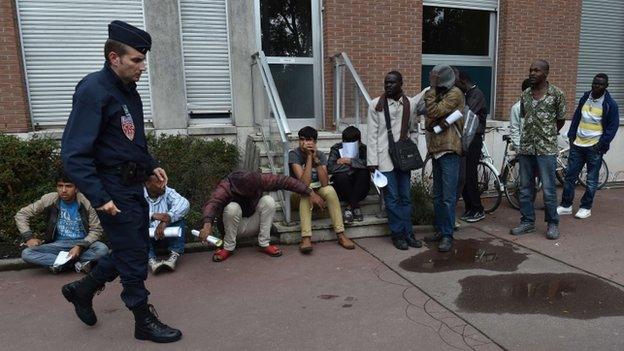
Attempts by migrants in Calais to travel to the UK have provoked much media coverage
Under the Dublin Regulation,, external refugees should be screened in the country in which they arrive.
Until recently, the majority of migrants were arriving off the coast of Italy.
Under the rules, they were supposed to be fingerprinted and their application for asylum processed.
As the numbers increased, the rules in many cases were abandoned.
Many migrants were given papers and waved through. Within 24 hours, as we discovered on one occasion, they were crossing the Austrian border.
Many were heading for Sweden which had opened its doors to refugees, particularly those from the war in Syria.
The system for processing refugees was broken but moving people on reduced the political pressure inside Italy.
And in any case, it was not fair for Italy and Greece to shoulder the burden alone for dealing with a humanitarian crisis on this scale.
Succession of tragedies
Then in 2013, there was the tragedy off Lampedusa when 300 people, mainly from Eritrea and Somalia, lost their lives within sight of the Italian island.
Other tragedies followed and Europe deployed more ships to patrol the Mediterranean.

People continue to risk their lives to cross the Mediterranean for a new life in Europe
Privately many European leaders wrestled with a dilemma.
There was the humanitarian imperative to save lives but there was a risk that the safer they made the Mediterranean crossing, the more people would be tempted to make the journey.
Publicly they did not say that their actions would bring more migrants to Europe.
They promised to go after the traffickers who were operating from Libya's lawless coast.
It sounded - as it was meant to - that military action against the traffickers would ease the problem.
That mission is still in its first phase - intelligence-gathering.
For tens of thousands of people, Europe became a place of safety and opportunity and they were prepared to risk everything to get there.
They understood that if they reached Europe there was little risk of them being sent back.
Already thousands of people from Eritrea, Somalia, Sudan, Afghanistan and Iraq were on the move.
Syrian conflict
Their numbers were swelled by refugees from the war in Syria.
Some four million Syrians have fled their country, external and many are living in appalling conditions in makeshift camps. Europe is their dream.
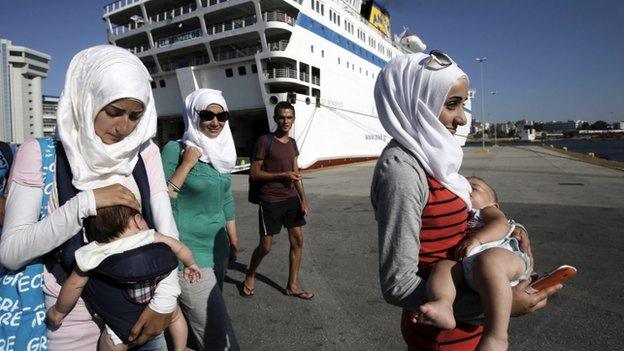
Many Syrian refugees have travelled to Greece
The potential scale of the problem is immense. The UN says the number of displaced people around the world is nearly 60 million, external.
In Europe, the two countries that took in the majority of these refugees were Germany and Sweden. Germany processed 43% of all existing asylum applications.
Gradually, the migrant routes changed.
There were still people crossing the Mediterranean but many more were heading to Greece from Turkey and then using a land route through Macedonia, the Western Balkans to Germany.
And despite the horrific journeys, many more families and children were found walking or packed in cars and vans.
Germany was generous in the welcome it gave those fleeing the brutal conflict in Syria.
Political leaders portrayed its open door policy as reflecting European values.
It helps that Germany needs workers - there are nearly 600,000 unfilled posts in the country.
Internal tensions
There have been some protests over the new arrivals.
More than 200 acts of aggression against refugees or the centres where they are living have been reported.
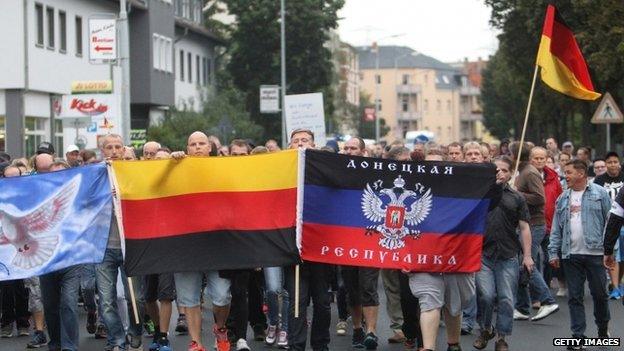
Migration has led to protests in Germany
Even though she was booed, external in one community in eastern Germany, Angela Merkel was defiant when she told the crowd: "There can be no tolerance for those people who question the dignity of others, who are not willing to help where legal and human help is required."
But then Germany's interior minister revealed that Germany might accept 800,000 migrants this year, external. The figures seemed to be growing on a daily basis.
And some were almost certainly economic migrants. A third of those arriving in Germany were from Albania, Kosovo and Serbia.
Mrs Merkel said at the weekend that "in order to be able to help those in distress, we also must tell those who are not in distress that they cannot stay with us".
The sheer scale of the crisis has left politicians floundering for answers.
The German chancellor has said: "If we don't succeed in fairly distributing refugees, then of course the Schengen question will be on the agenda for many."
What Angela Merkel was hinting at was that passport-free travel (a principle enshrined in the Schengen agreement) could be challenged.
Way forward
So what is to be done?
Firstly, it is much easier to go after traffickers in mainland Europe.
After 71 people died in a van, the Austrian authorities are carrying out border checks.
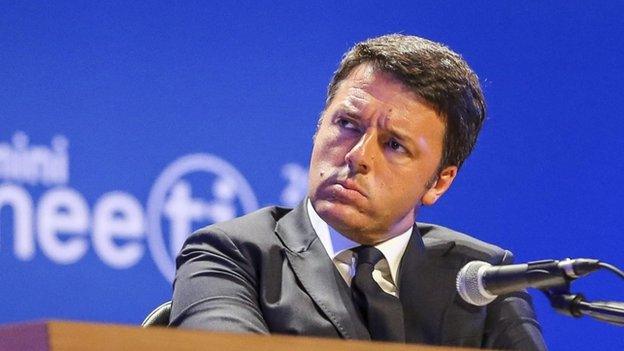
Matteo Renzi has called for a single European asylum policy
French Interior Minister Bernard Cazeneuve said: "People smugglers who belong to international criminal gangs must be prosecuted, external and their organisations dismantled."
That might save some lives but it is unlikely to affect the numbers travelling.
The European Commission wants "automatic redistribution" of refugees among all the member states.
Italian Prime Minister Matteo Renzi believes there will have to be a single European asylum policy.
Many countries, however, will be unwilling to accept quotas decided in Brussels.
Britain, in the midst of renegotiating its relationship with the EU, would not agree to such measures.
In any event, dispersing refugees would have only a short-term impact.
Most migrants want to join existing communities from their own countries.
Reception centres
There is a plan to set up large reception centres, external in Greece and Italy funded by the EU and run by international agencies.
Migrants would be looked after while their application for asylum was assessed.
It might bring some order to the current chaos but such centres would struggle to operate efficiently with the numbers travelling.
There is also discussion about identifying what are called "safe states of origin" - places that are deemed safe enough for migrants to be returned to, particularly in Africa.
In exchange for those countries taking back migrants, they would be given extensive EU investment.
There is also talk of setting up reception centres in Africa and possibly the Middle East where applications to come to the EU would be processed.
It is clear that Europe is going to try to once again make a distinction between those fleeing war and so-called economic migrants.
But would Europe, on any significant scale, deport refugees? And yet privately some politicians are saying that sooner or later it will have to happen.
Others insist that a relatively prosperous Europe should be able to open its doors to hundreds of thousands of refugees and so provide answers to shrinking and ageing populations.
The politics in all this are sensitive. Anti-immigrant parties in France, Italy, Sweden and Denmark are polling strongly.
The German Chancellor says: "If Europe fails on this question of refugees… then it won't be the Europe we wished for."


Schengen Agreement:
The Schengen Agreement led to the creation of Europe's borderless Schengen Area.
The treaty was signed on 14 June 1985 by five of the 10 member states of the European Economic Community near the town of Schengen in Luxembourg, but wasn't implemented for a further decade.
It proposed the gradual abolition of border checks at the signatories' common borders.
The Schengen Area operates very much like a single state for international travel purposes.
There are external border controls for travellers entering and exiting the area and common visas, but no internal border controls.
It currently consists of 26 European countries covering a population of more than 400 million people. The UK and Republic of Ireland have opted out.
